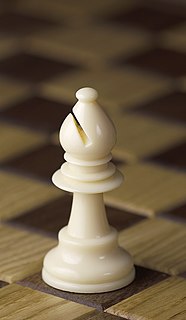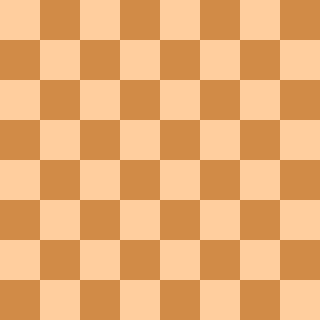Chess strategy is the aspect of chess play concerned with evaluation of chess positions and setting of goals and long-term plans for future play. While evaluating a position strategically, a player must take into account such factors as the relative value of the pieces on the board, pawn structure, king safety, position of pieces, and control of key squares and groups of squares. Chess strategy is distinguished from chess tactics, which is the aspect of play concerned with the move-by-move setting up of threats and defenses. Some authors distinguish static strategic imbalances, which tend to persist for many moves, from dynamic imbalances, which are temporary. This distinction affects the immediacy with which a sought-after plan should take effect. Until players reach the skill level of "master", chess tactics tend to ultimately decide the outcomes of games more often than strategy does. Many chess coaches thus emphasize the study of tactics as the most efficient way to improve one's results in serious chess play.

The king is the most important piece in the game of chess. In algebraic notation, the king is abbreviated in English by the letter K. If a player's king is threatened with capture, it is said to be in check, and the player must remove the threat of capture on the next move. If this cannot be done, the king is said to be in checkmate, resulting in a loss for that player. Players cannot make any move that places their own king in check. Although the king is the most important piece, it is one of the weakest pieces in the game outside of the endgame.

The bishop is a piece in the game of chess. Each player begins the game with two bishops. One starts between the king's knight and the king, the other between the queen's knight and the queen. The starting squares are c1 and f1 for White's bishops, and c8 and f8 for Black's bishops.
In chess and chess-like games, the endgame is the stage of the game when few pieces are left on the board.
The fifty-move rule in chess states that a player can claim a draw if no capture has been made and no pawn has been moved in the last fifty moves. The purpose of this rule is to prevent a player with no chance of winning from obstinately continuing to play indefinitely or seeking to win by tiring the opponent.
In the game of chess, an endgame study, or just study, is a composed position—that is, one that has been made up rather than played in an actual game—presented as a sort of puzzle, in which the aim of the solver is to find the essentially unique way for one side to win or draw, as stipulated, against any moves the other side plays. There is no limit to the number of moves which are allowed to achieve the win; this distinguishes studies from the genre of direct mate problems. Such problems also differ qualitatively from the very common genre of tactical puzzles based around the middlegame, often based on an actual game, where a decisive tactic must be found.

Stalemate is a situation in the game of chess where the player whose turn it is to move is not in check but has no legal move. The rules of chess provide that when stalemate occurs, the game ends as a draw. During the endgame, stalemate is a resource that can enable the player with the inferior position to draw the game rather than lose. In more complex positions, stalemate is much rarer, usually taking the form of a swindle that succeeds only if the superior side is inattentive. Stalemate is also a common theme in endgame studies and other chess problems.

Checkmate is a game position in chess and other chess-like games in which a player's king is in check and there is no way to avoid the threat. Checkmating the opponent wins the game.
In chess, the chess piece relative value system conventionally assigns a point value to each piece when assessing its relative strength in potential exchanges. These values help determine how valuable a piece is strategically. They play no formal role in the game but are useful to players.

The Philidor position usually refers to an important chess endgame which illustrates a drawing technique when the defender has a king and rook versus a king, rook, and a pawn, though it can also refer to a position in the queen versus rook endgame or a position in a rook and bishop versus rook endgame. In the case of a rook and pawn versus a rook, it is also known as the third rank defense, because of the importance of the rook on the third rank cutting off the opposing king. It was analyzed by François-André Danican Philidor in 1777. Many rook and pawn versus rook endgames reach either the Philidor position or the Lucena position. If played accurately the defending side tries to reach the Philidor position; the other side tries to reach the winning Lucena position. Some consider this to be one of the most important positions in endgame theory".
The exchange in chess refers to a situation in which one player exchanges a minor piece for a rook. The side which wins the rook is said to have won the exchange, while the other player has lost the exchange, since the rook is usually more valuable. Alternatively, the side that has won the rook is up the exchange, and the other player is down the exchange. The opposing captures often happen on consecutive moves, although this is not strictly necessary. It is generally detrimental to lose the exchange, although occasionally one may find reason to purposely do so; the result is an exchange sacrifice. The minor exchange is an uncommon term for the exchange of a bishop and knight.
In chess, the fortress is an endgame drawing technique in which the side behind in material sets up a zone of protection that the opponent cannot penetrate. This might involve keeping the enemy king out of one's position, or a zone the enemy cannot force one out of. An elementary fortress is a theoretically drawn position with reduced material in which a passive defense will maintain the draw.
In chess, a blunder is a critically bad move. It is usually caused by some tactical oversight, whether it be from time trouble, overconfidence or carelessness. Although blunders are more common in amateur games, all players make them, even at the world championship level. While the opponent making a blunder may seem like a stroke of luck, giving the opponent opportunities to blunder is an important skill in over the board chess.
In chess, a desperado piece is a piece that is en prise or trapped, but captures an enemy piece before it is itself captured. This can be in either a situation where both sides have hanging pieces, "...in which you use your doomed piece to eat as much material as possible before it dies"; or alternatively a sacrifice that will result in stalemate if it is captured.
A pawnless chess endgame is a chess endgame in which only a few pieces remain and none of them is a pawn. The basic checkmates are types of pawnless endgames. Endgames without pawns do not occur very often in practice except for the basic checkmates of king and queen versus king, king and rook versus king, and queen versus rook. Other cases that occur occasionally are (1) a rook and minor piece versus a rook and (2) a rook versus a minor piece, especially if the minor piece is a bishop.
Chess endgame literature refers to books and magazines about chess endgames. A bibliography of endgame books is below.
In chess endgames with a bishop, a pawn that is a rook pawn may be the wrong rook pawn. With a single bishop, the result of a position may depend on whether or not the bishop controls the square on the chessboard on which the pawn would promote. Since a side's rook pawns promote on opposite-colored squares, one of them may be the "wrong rook pawn". This situation is also known as having the wrong-colored bishop or wrong bishop, i.e. the bishop is on the wrong colored squares in relation to the rook pawn. In many cases, the wrong rook pawn will only draw, when any other pawn would win. A fairly common defensive tactic is to get into one of these drawn endgames, often through a sacrifice.

The wrong bishop is a situation in a chess endgame in which a bishop on the other color of square of the chessboard would either win a game instead of draw or salvage a draw from an inferior position ; in other words, a bishop is unable to guard squares of the other color. This most commonly occurs with a bishop and one of its rook pawns, but it also occurs with a rook versus a bishop, a rook and one rook pawn versus a bishop, and possibly with a rook and one bishop pawn versus a bishop.
Omega Chess is a commercial chess variant designed by Daniel MacDonald. The game is played on a 10×10 board with four extra squares, each added diagonally adjacent to the corner squares. The game is laid out like standard chess with the addition of a champion in each corner of the 10×10 board and a wizard in each new added corner square.

The following outline is provided as an overview of and topical guide to chess:







